| 2021 |
|---|
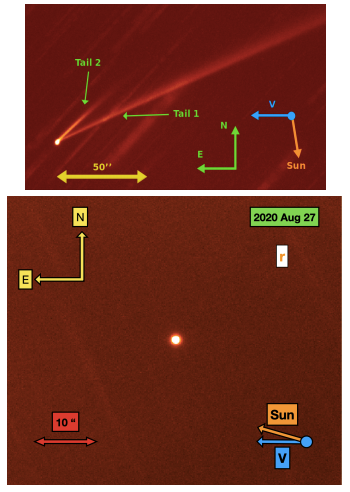 | Dr. Zhong-Yi Lin: We observed Episodically Active Asteroid (6478) Gault in 2020 with multiple telescopes in Asia and North America and have found that it is no longer active after its recent outbursts at the end of 2018 and start of 2019. The inactivity during this apparition allowed us to constrain Gault’s rotation period using time-series photometric lightcurves taken over 17 h on multiple days in 2020 August, September and October. The photometric lightcurves have a repeating 0.05 magnitude feature suggesting that Gault has a rotation period of ∼2.5 hours and may have a semi-spherical or top-like shape, much like Near-Earth Asteroids Ryugu and Bennu. The rotation period of ∼2.5 hours is near to the expected critical rotation period for an asteroid with the physical properties of Gault suggesting that its activity observed over multiple epochs is due to surface mass shedding from its fast rotation spun up by the YORP effect. |
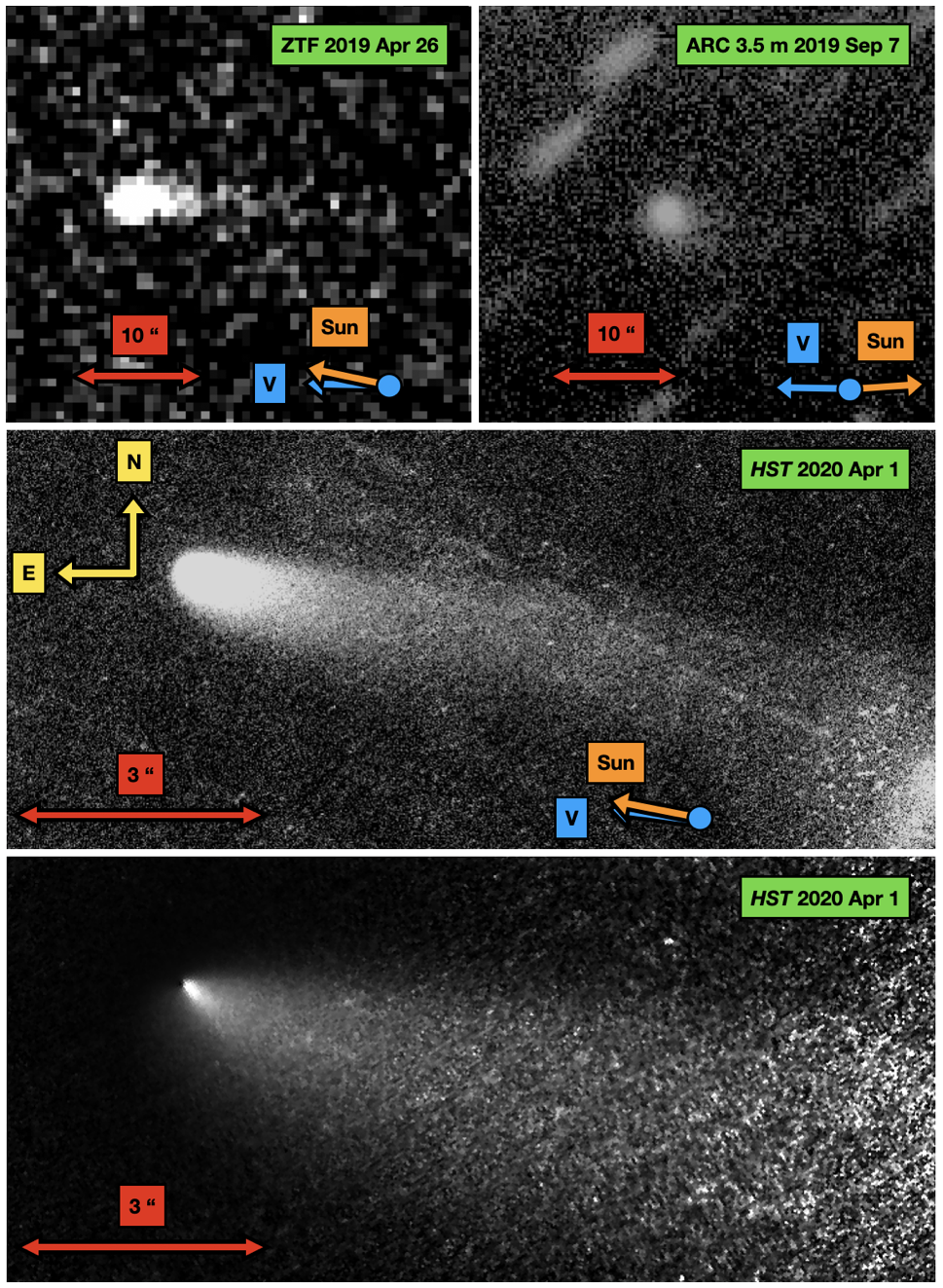 | Dr. Zhong-Yi Lin: We present visible and mid-infrared imagery and photometry of temporary Jovian co-orbital comet P/2019 LD2 taken between 2019 April and 2020 August. Our observations indicate that the nucleus of LD2 has a radius between 0.2-1.8 km assuming a 0.08 albedo. We measure CO/CO2 gas production of ≤1027 mol/s /≤1026 mol/s from our 4.5 μm Spitzer observations, g-r = 0.59±0.03, r-i = 0.18±0.05, i-z = 0.01±0.07 from GROWTH observations, H2O gas production of ≤80 kg/s scaling from our estimated C2 production of QC2 ≤7.5×1024 mol/s from Keck/LRIS spectroscopy. In the simulations, we find that the clones entered the Jovian region approximately 2.37 years ago, and are ejected from the region 8.70 years in the future. Using these transition object population estimates and our estimate of the radius of P/2019 LD2 of ∼1.8 km suggests there are ∼100 objects with the size of P/2019 LD2 in the transition region at any given time. |
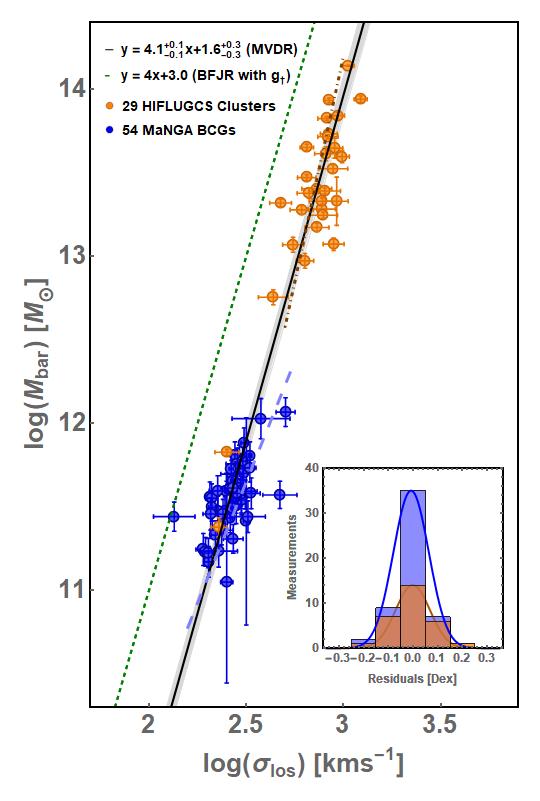 | Caption: The mass-velocity dispersion relation (MVDR) on BCG-cluster scales
Dr. Yong Tian: For the first time, we discovered a tight kinematic scaling relation on the BCG-cluster scale. In this figure, the vertical axis represents the total baryonic mass Mbar, while the horizontal axis represents the flat velocity dispersion σ. This relation strongly indicates Mbar α σ4, so called mass-velocity dispersion relation (MVDR). Moreover, the velocity dispersion profile of BCGs demonstrates a nearly flat tail, even in the innermost region. This result is published in Tian et al. 2021, ApJL, 917, L24 (Including Prof. Chung-Ming Ko and Han Cheng).
DOI: 10.3847/2041-8213/ac1a18 |
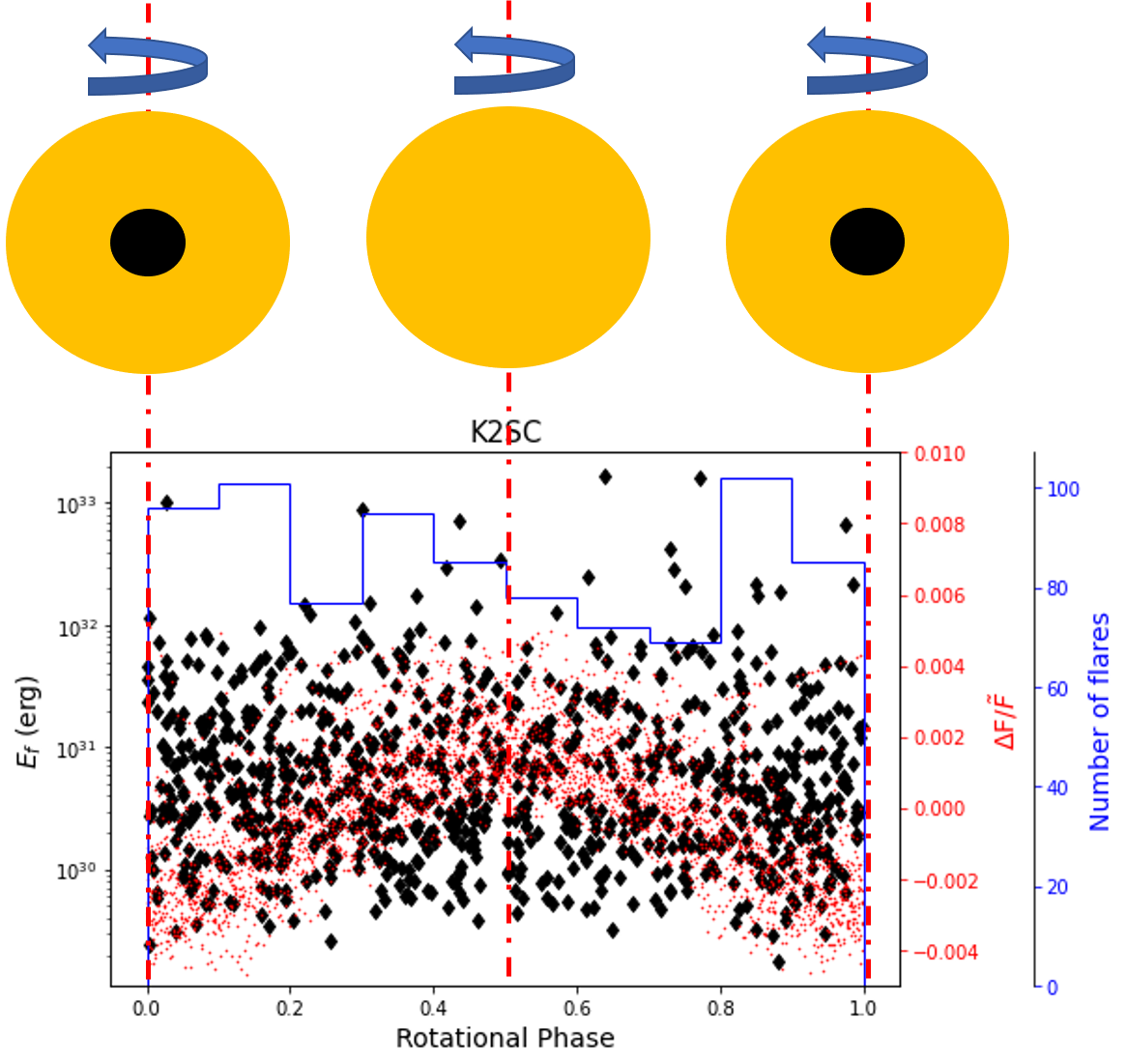 | Caption: The relation between Wolf 359’s flare activity (numbers in the blue histogram and energies in the black rhombi) and stellar rotational phase (red dots) which displays the possible dark spots concentrated region on the photosphere.
PhD student Chia-Lung Lin: Wolf 359 is an M5 young flaring red dwarf and the fifth closest star to the Sun. It is also an exoplanet-hosting candidate with at least two possible exoplanets. The star was a target of the K2 mission observed by the EDEN project, which is a global network of 1–2 m class telescopes for detection and characterization of rocky exoplanets in the habitable zones of nearby late-M dwarfs. In the combination of the K2 data and our EDEN observations (~ 80 days), a total of 872 flares have been detected, suggesting that Wolf 359 is able to produce more than 10 flares per day. The most violent flare releases energy up to about 10 times powerful than the biggest solar flare in the record and wolf 359 can produce 10 times per year. On the other hand, the flare tends to explode near the dark spots based on the solar observations. However, no correlation of flare activity, i.e. numbers and energies, with the stellar rotational phase that reflects possible spots concentrated region, was found on Wolf 359 (see Figure above).
This study has been published in Astronomical Journal:
Lin, C.-L., Chen, W.-P., Ip, W.-H., et al. 2021, AJ, 162, 11 (Including Prof. Chen and Prof. Ip in the institute).
DOI: 10.3847/1538-3881/abf933
|
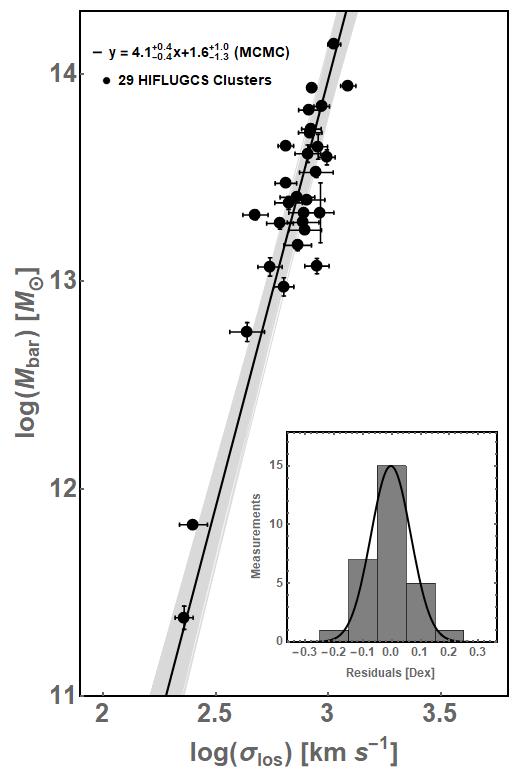 | Caption: The mass-velocity dispersion relation in galaxy clusters
Dr. Yong Tian: For the first time, we discovered a tight kinematic scaling relation. . In this figure, the axes are from two independent measurements: (1) the total baryonic mass Mbar including X-ray gas mass and stellar mass of member galaxies; (2) the flat velocity dispersion σ by the velocity distribution of member galaxies. This relation indicates Mbar α σ4 highly similar to the Tully-Fisher relation in spiral galaxies, whereas the intercept implies a much larger acceleration scale. This result confirms our previous prediction of the acceleration relation in galaxy clusters (
Tian et al. 2020, APJ, 896, 70
). This result is published in
Tian et al. (2021), ApJ, 910, 56
(Including Chung-Ming Ko).
DOI: 10.3847/1538-4357/abe45c |
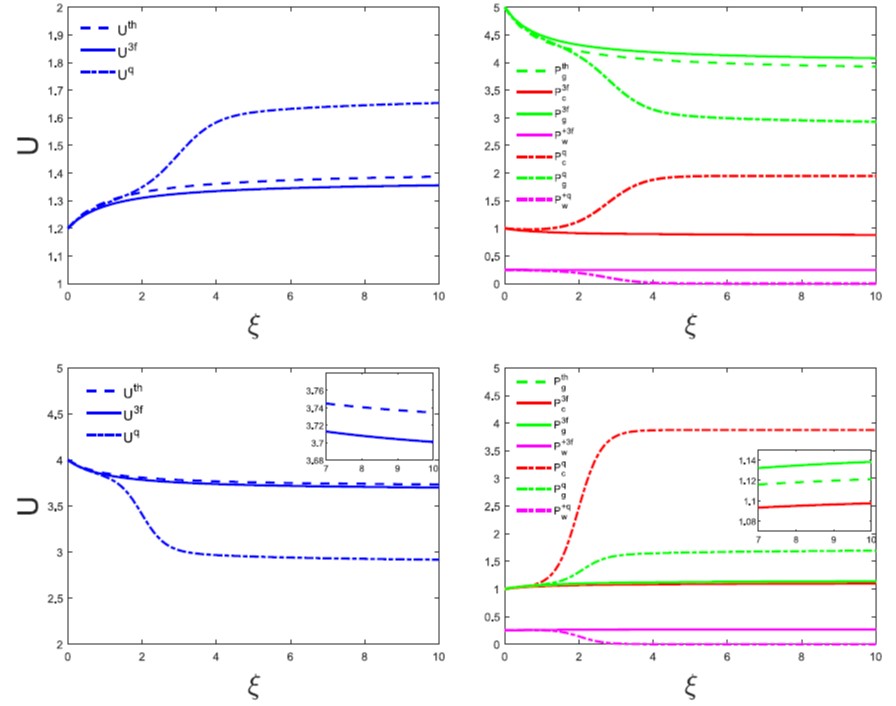 | Caption: Outflows in the presence of cosmic rays and waves
PhD student Bilal Ramzan: Plasma outflow against a gravitational potential is usually referred to as a thermal outflow in galaxies. If thermal gas comes under the influence of cosmic rays, then we refer to them as cosmic ray accompanied outflows. We present a very interesting dependence of cosmic ray diffusion coefficient on waves (i.e., strong coupling case) in the context of hydrodynamics. There are two possible classes of outflows depending upon the suitably defined sound speed. One is subsonic outflows and the other one is supersonic. In the given figure, we show that how different velocity and pressure profiles behave under the same set of boundary conditions. Thermal outflow and cosmic ray accompanied outflow look very similar. Quasi-thermal outflow looks similar to the other two types near the base, but somewhere along the flow waves become decoupled from the thermal gas and the flow becomes pure thermal outflow. Furthermore, we add non-linear Landau damping effects on the different outflow profiles. This result is published in Ramzan et al. (2020), ApJ, 905, 117 (Including Chung-Ming Ko).
DOI: 10.3847/1538-4357/abc82b |
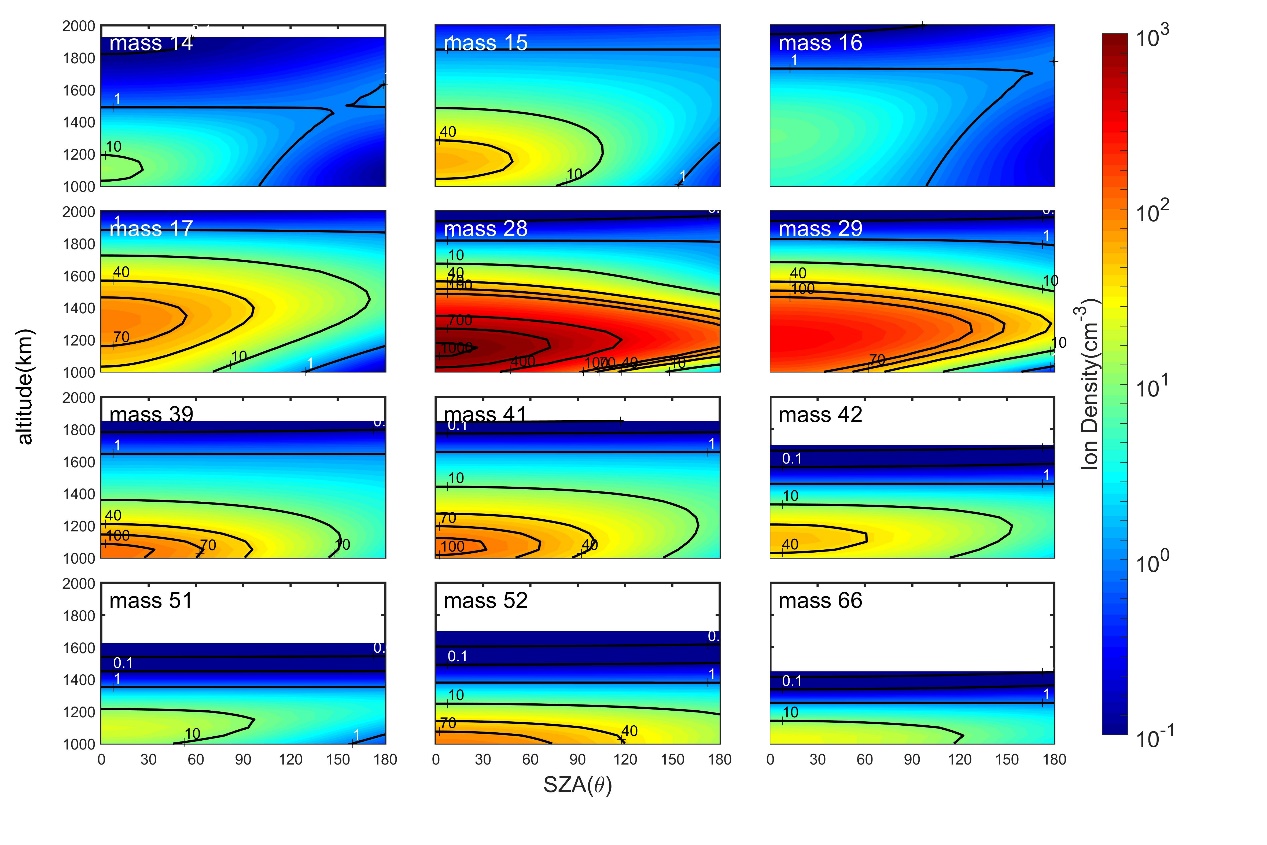 | Figure: Contour plots of ion density distributions in the SZA-Z coordinate. The ion species include light ions (14–17), major ions (28–29), and heavy ions (39–66).
Dr. Jen-Kai Hsu: Titan, the largest moon of Saturn, is the only moon known to have a dense nitrogen-rich atmosphere similar to that of the Earth. In the past 13 years, Cassini had in total 127 targeted Titan encounters, providing a large amount of research data for research and analysis. We produced Titan reference ionospheric models by using the measurements of the Ion and Neutral Mass Spectrometer (INMS) onboard Cassini.
The spatial distributions are quite different between the primary ions and major ions due to the different generated mechanism. For the larger mass ion species, with long chemical lifetimes, we found that the altitudes of the density peaks are lower the larger the mass. And due to the day-to-night ionospheric transport, the diurnal variations of heavy ions are significantly less than those of the primary ions and the major ion species. This work has been published in The Planetary Science Journal: Hsu, J.-K. and Ip, W.-H., et al. 2021, PSJ, 2, 4 (Including Prof. W.-H. Ip).
DOI: https://doi.org/10.3847/PSJ/ac11ff |







